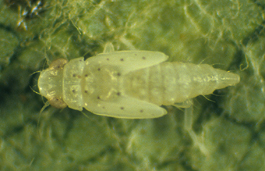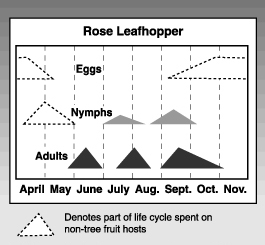by Elizabeth H. Beers and Erwin A. Elsner, originally published 1993
Edwardsiana rosae (Linnaeus) (Homoptera: Cicadellidae)

The rose leafhopper is the second most common species of leafhopper on apple and has also been found on pear. Because it is similar in appearance, feeding habits, and life cycle to white apple leafhopper, they have often been mistaken for each other. It can occur in mixed populations with white apple leafhopper or as the dominant species.
Hosts
The rose leafhopper appears to overwinter only on rose (woody plants in the genus Rosa) but can use other plants as hosts during summer generations. Tree fruit hosts include apple, pear, plum, and cherry.
Life stages
All life stages look similar to white apple leafhopper, but the two species can be distinguished in several stages. Rose leafhopper nymphs have rows of dark spots at the bases of strong setae, on the back of the thorax, including the wingpads. The spots are less distinct in the early instars but are clearly visible in the older nymphs. Adult rose leafhoppers are the same size and color as white apple leafhoppers, but both males and females can be distinguished by differences in their genitalia. However, identification of females is difficult.
Life history
 Unlike white apple leafhopper, which has two generations per year, rose leafhopper has three. This species overwinters in the egg stage on the stems of roses, which cause the same crescent-shaped swelling as white apple leafhopper. Eggs begin to hatch in early to mid-April, and nymphs are present until early June. First generation nymphs are confined to the overwintering host. Adults of this generation are active from late May through late June. Second and third generations are produced either on rose or one of the tree fruit hosts. Second generation nymphs occur during July, with adults active from mid-July through mid-August. Third generation nymphs occur from late August through September, and adults are active from early September through frost.
Unlike white apple leafhopper, which has two generations per year, rose leafhopper has three. This species overwinters in the egg stage on the stems of roses, which cause the same crescent-shaped swelling as white apple leafhopper. Eggs begin to hatch in early to mid-April, and nymphs are present until early June. First generation nymphs are confined to the overwintering host. Adults of this generation are active from late May through late June. Second and third generations are produced either on rose or one of the tree fruit hosts. Second generation nymphs occur during July, with adults active from mid-July through mid-August. Third generation nymphs occur from late August through September, and adults are active from early September through frost.
Damage, monitoring and natural enemies are the same as for white apple leafhopper. While little research information is available, it appears that insecticides used against white apple leafhopper will also be effective against rose leafhopper.

